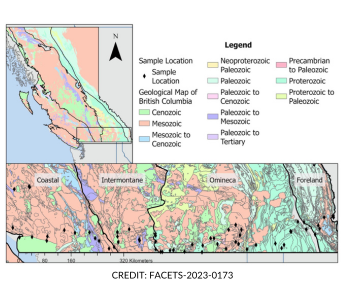Abstract
Strontium isotopes are used for provenience and mobility studies in archaeology, ecology, and forensic studies, and rely on accurate baseline maps that are used to compare and interpret human and animal strontium ratios. Here, we present a bioavailable 87Sr/86Sr map, also called an isoscape, for southern British Columbia derived from modern plant samples’ 87Sr/86Sr ratios. We sampled 67 medium root depth plants over a 900 km transect from the southern BC coast to inland BC to capture the natural 87Sr/86Sr ratios of plants along the four major geological belts in British Columbia. Non-parametric Kruskal–Wallis and pairwise Wilcox tests were used to examine whether the geological belts had statistically significant mean differences. It was found that the province could be effectively divided into east and west, with the Coastal–Intermontane and Omineca–Foreland regions having statistically different means from each other. 87Sr/86Sr ratios had statistically significant relationships with salt deposition, volcanic deposition, and mean age of the underlying lithology. Generally, 87Sr/86Sr ratios increased with distance from the coast as the atmospheric input of radiogenic strontium from marine-derived rainwater decreased and the input of radiogenic strontium isotopes from the underlying geology of the Rockies in the far east of the province increased.
Introduction
Strontium isotope analysis has become an increasingly useful technique in geology, ecology, archaeology, and forensic science (Price et al. 2002; Hodell et al. 2004; Evans et al. 2010; Copeland et al. 2011; Makarewicz and Sealy 2015; Bataille et al. 2018; Emery et al. 2018; Holt et al. 2021; Kramer et al. 2022). Often, strontium analysis is used to study the geographic origin of materials or individuals (Bentley 2006; Holt et al. 2021), and uses the 87Sr/86Sr ratio, which is the ratio of the heavier and more rare strontium-87 to the lighter and more abundant strontium-86 (Holt et al. 2021). The method compares the local bioavailable 87Sr/86Sr ratios to the 87Sr/86Sr ratios of human or animal tissues, usually enamel, to infer whether they were local or non-local, and where they may have migrated from (see Bentley (2006), Coelho et al. (2017), and Holt et al. (2021) for comprehensive reviews).
In archaeology, 87Sr/86Sr ratios have been used to predict whether an individual is local or non-local to a region (whether their 87Sr/86Sr ratio is similar to the bioavailable 87Sr/86Sr ratios where they were buried) (Bentley 2006; Holt et al. 2021). In forensic science, it can be used to estimate a person’s mobility or to exclude possible countries of origin on a global scale (Bartelink and Chesson 2019). It has been used in food forensics to authenticate and provenance food (Kramer et al. 2022). Lastly, for ecology, it has been used to study the migration of animals throughout a landscape (Wooller et al. 2021).


